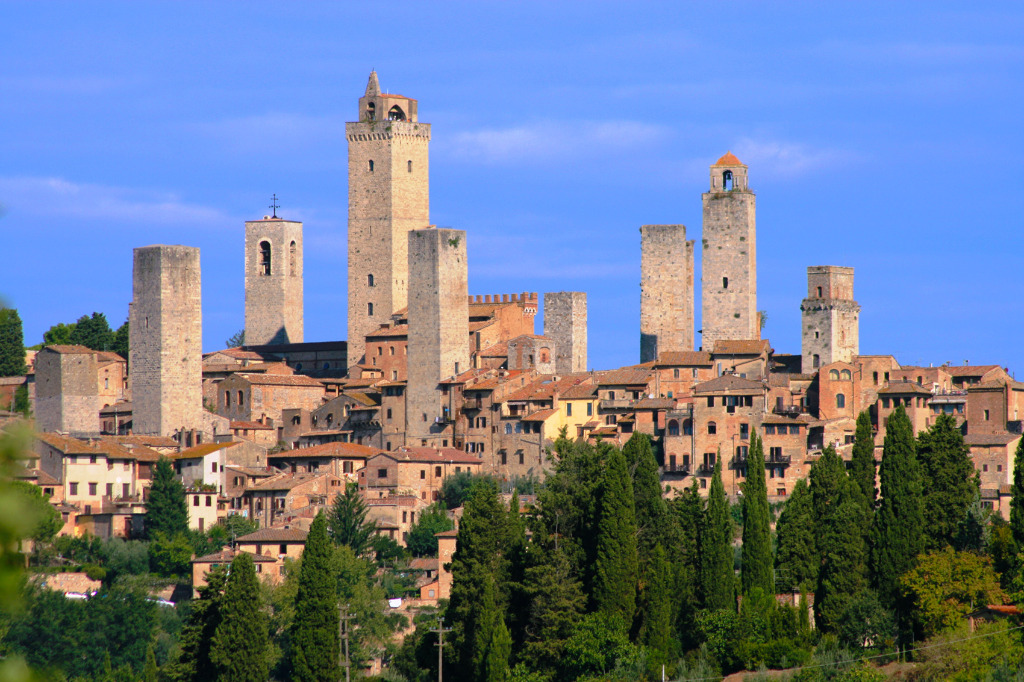San Gimignano, the Manhattan of the Middle Ages
San Gimignano – whose historic centre was declared a UNESCO World Heritage Site in 1990 - was erected on the ruins of an Etruscan village of the Hellenistic period (III-II century B.C.) and began to develop especially during the Middle Ages, thanks to its strategic position on the Via Francigena; originally under the jurisdiction of the bishops of Volterra, it became an independent commune in 1199 when the first podestà was established. Known as the City of Beautiful Towers – ancient symbols of wealth and power - San Gimignano entered a long period of economic prosperity that continued until 1351, when it fell under the influence of Florence; the commune was embellished with churches and public buildings and finally divided into four city quarters encircled by walls. Except for some restoration works carried out in the 18th – 19th century, the town has preserved its medieval aspect; it is considered today one of the best examples of urban organization during the Age of the Communes in Europe and attracts every year millions of visitors.
Should you decide to travel to this wonderful hill town, you have to know that there are so many great things to see, do and eat. Here is a list:
The Collegiate Church of Santa Maria Assunta – formerly a cathedral – stands in Piazza del Duomo and it is considered one of the best examples of Tuscan Romanesque; mainly known for its fresco cycles (described by UNESCO as works of outstanding beauty) it was completed in 1148.

The towers of course, the emblem of medieval Tuscany. The oldest one is the Torre Rognosa while the highest is the Torre Grossa. In the heyday there were 72 towers, today only 13 have survived.
Piazza della Cisterna, a triangle-shaped square surrounded by medieval palaces with a lovely well in the middle. Here stand also the famous Ardinghelli Towers (beheaded, like those of their bitter enemies) and the Medieval Criminal Museum, which displays all the scary devices and techniques of medieval torture, together with some interesting documents of the Holy Inquisition.

The majestic Church of St Augustine, the second largest church in town. Built in the 13th century, it contains precious frescoes and a magnificent altar by Benedetto da Maiano.
Palazzo Comunale (late 13th century) the seat of secular power, with its 19th century neogothic facade; from here you can access the Torre Grossa as well and enjoy a spectacular view of the town and the countryside.
From the courtyard of Palazzo Comunale climb the stairs to the Pinacoteca, which contains paintings from the Sienese and Florentine schools.
Visit the Galleria Continua, housed in the city's old theatre and its collection of contemporary artworks.

The Archaeological Museum and the Speziera di Santa Fina (a reconstructed 16th-century pharmacy and herb garden).
The Sacred Art Museum
The Fortress, the Ornithological Museum and the Vernaccia Wine Museum.
San Gimignano is located right in the middle of Tuscany, in a strategic position from which you can visit many other interesting places (Siena, Volterra, Monteriggioni, Certaldo, the Chianti area and Florence just to name a few) it offers also paths and tracks, which wind through valleys, woodlands and hills, so if you like outdoors activities you have another good reason to choose San Gimignano as a holiday destination. Lastly, some traditional products you should try at least once are the cinta senese charcuterie, the wildboar, the pheasant and of course, the wine!



